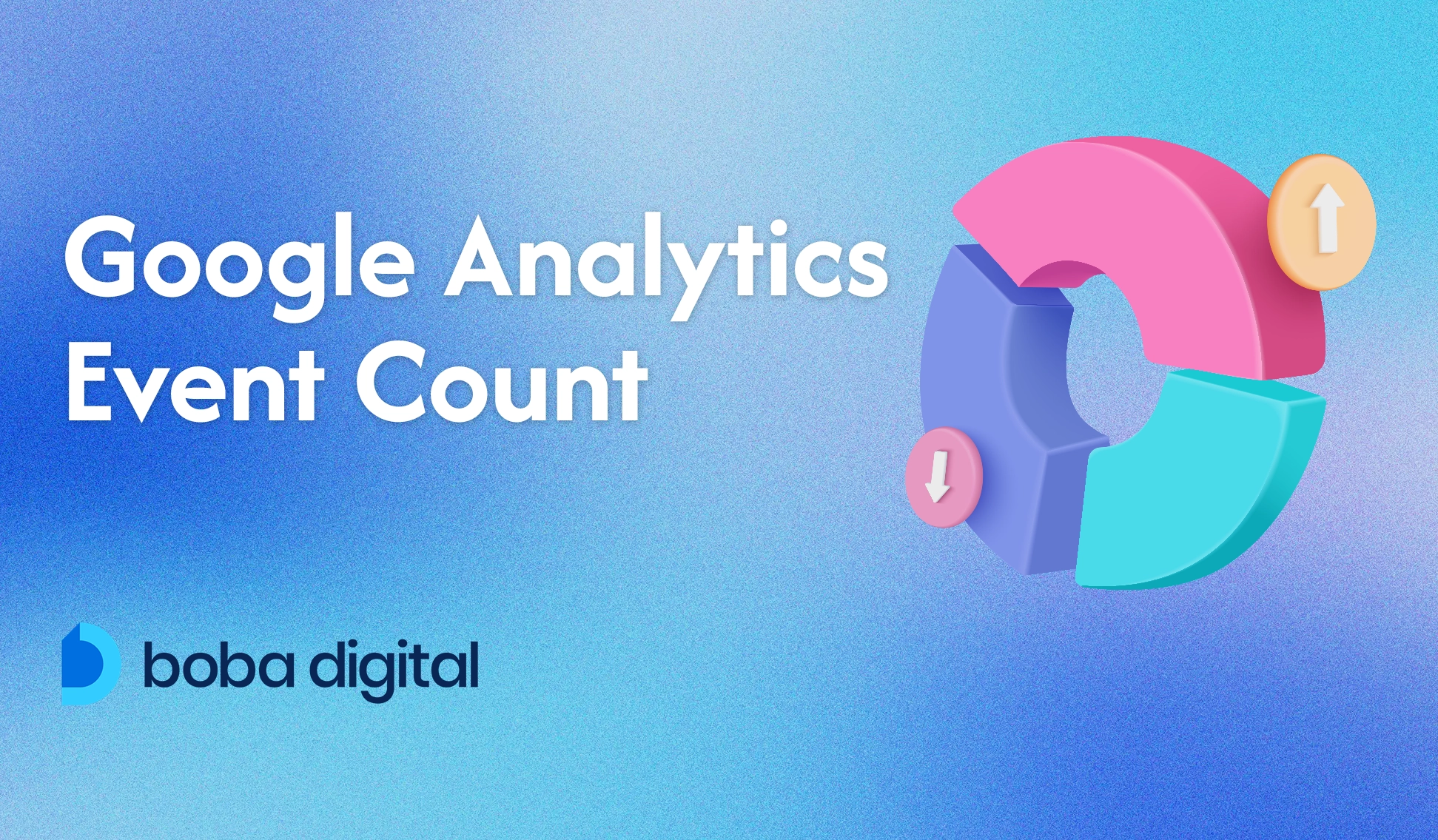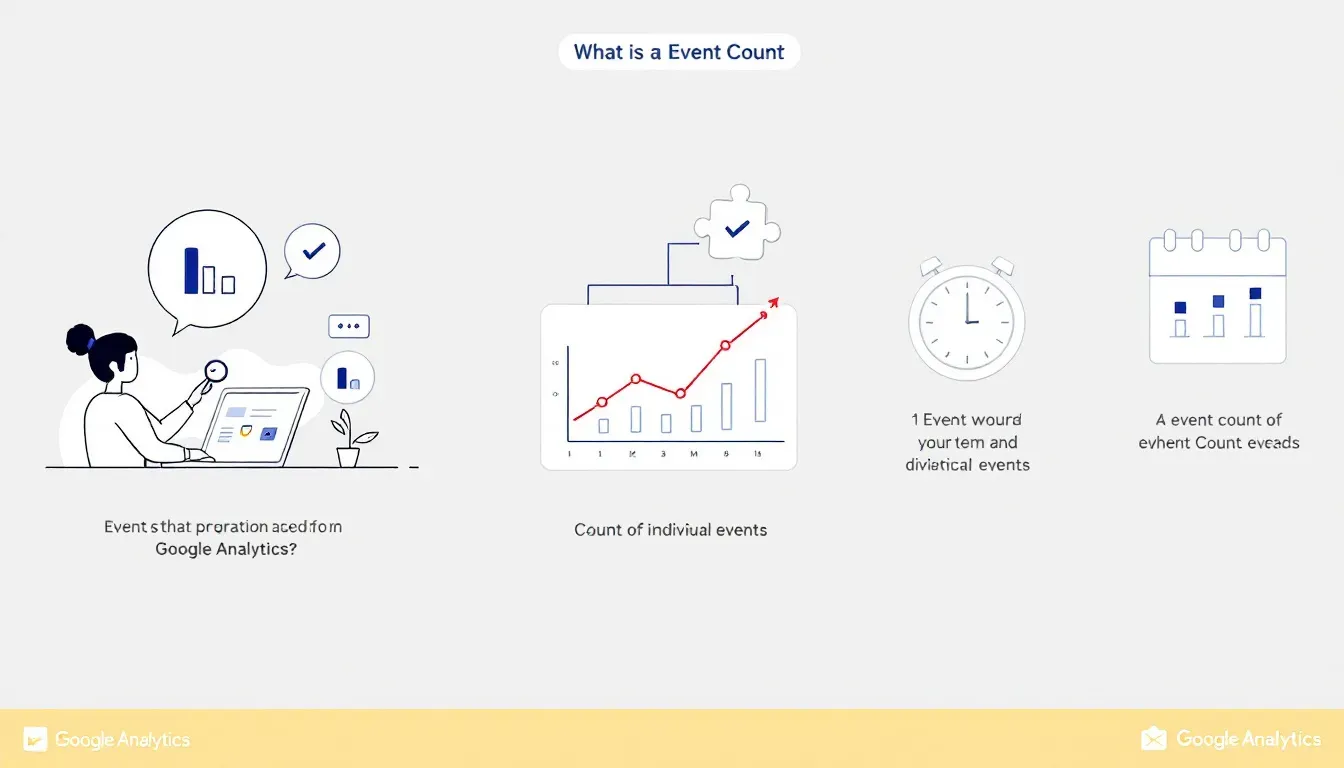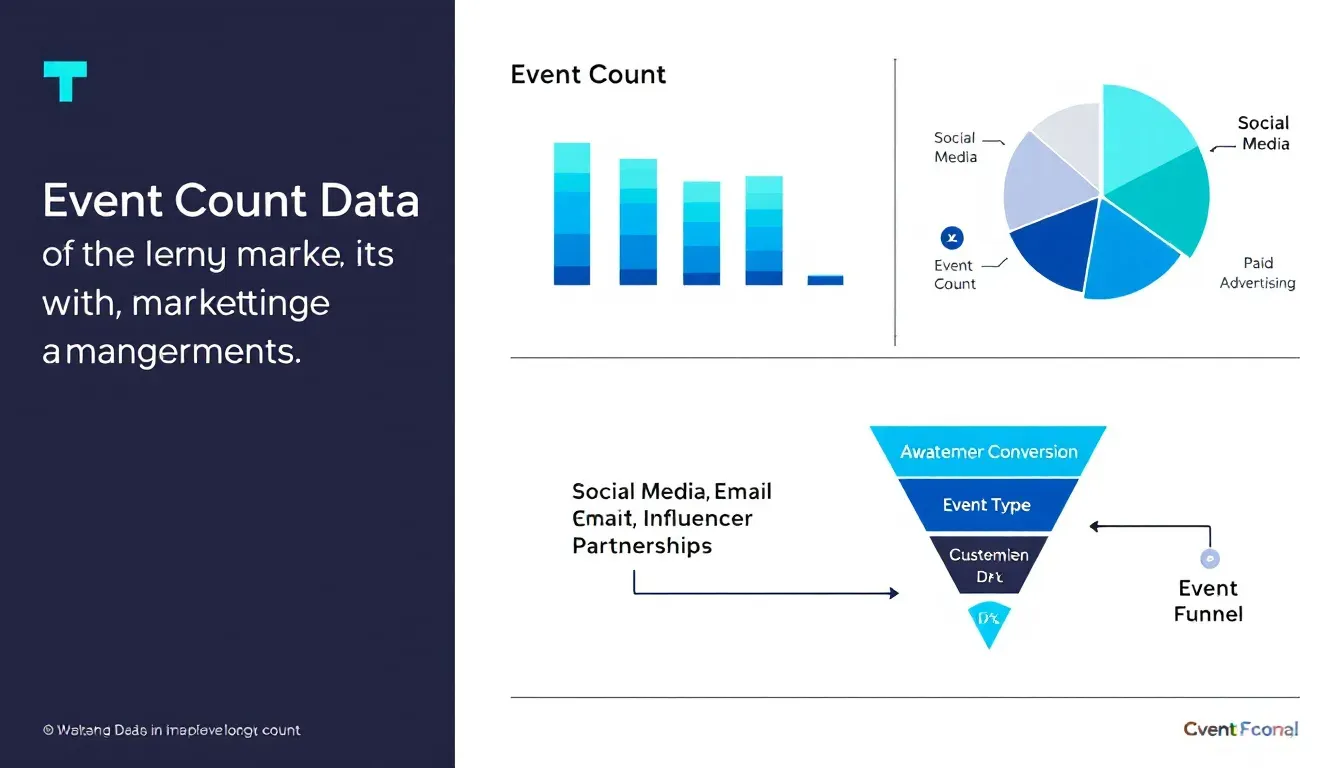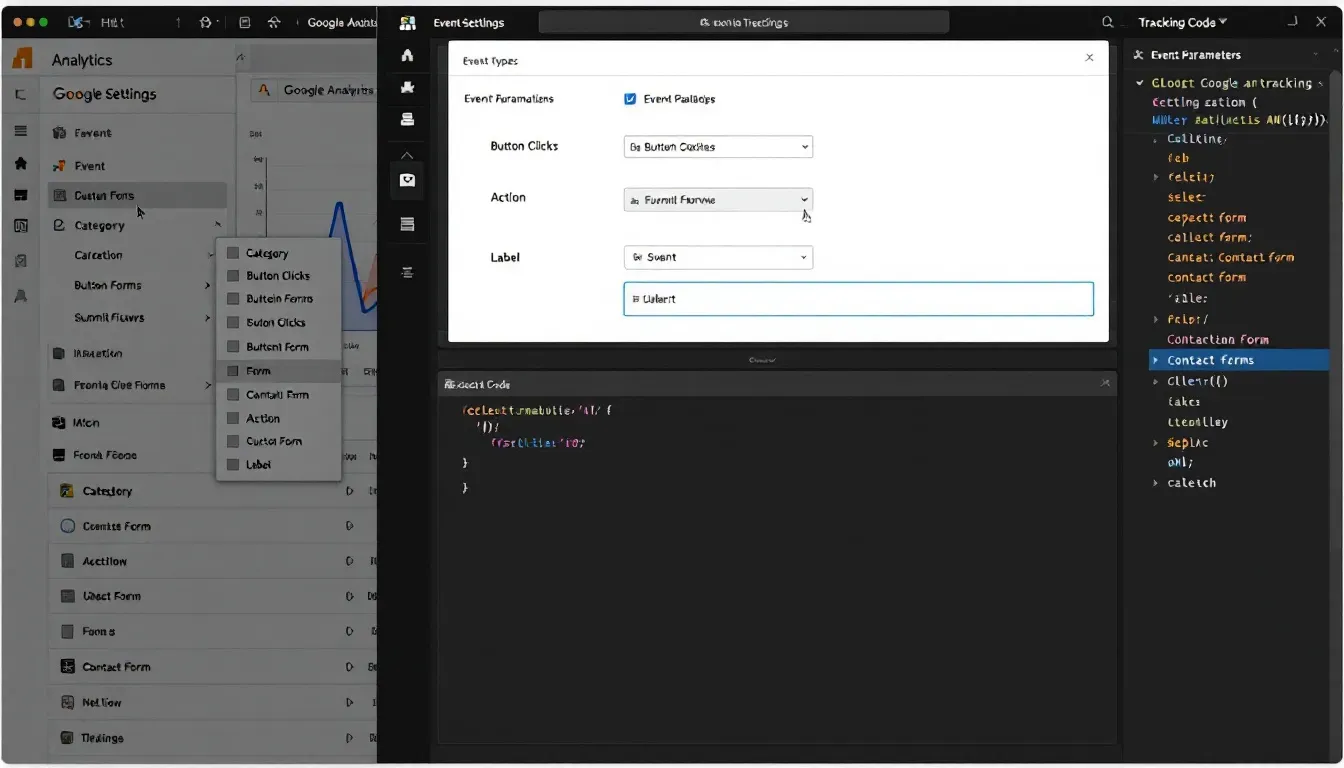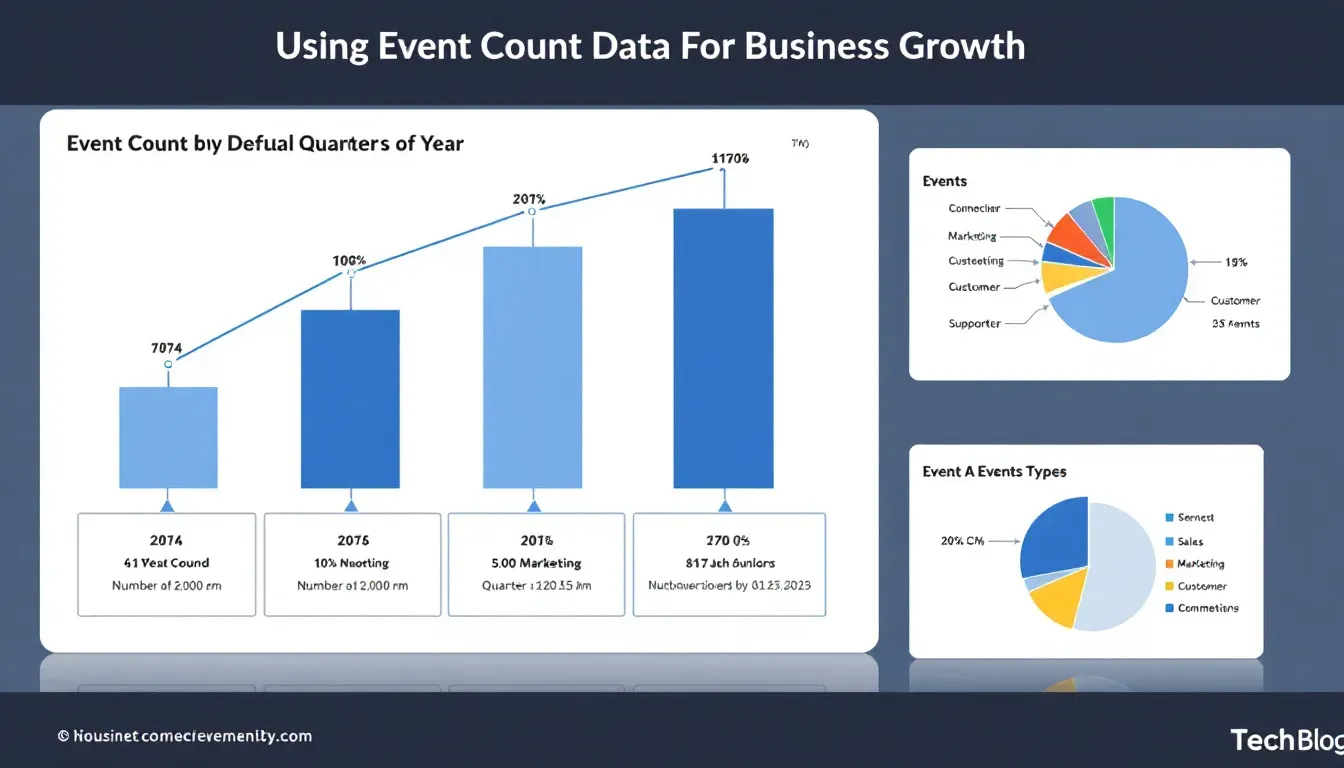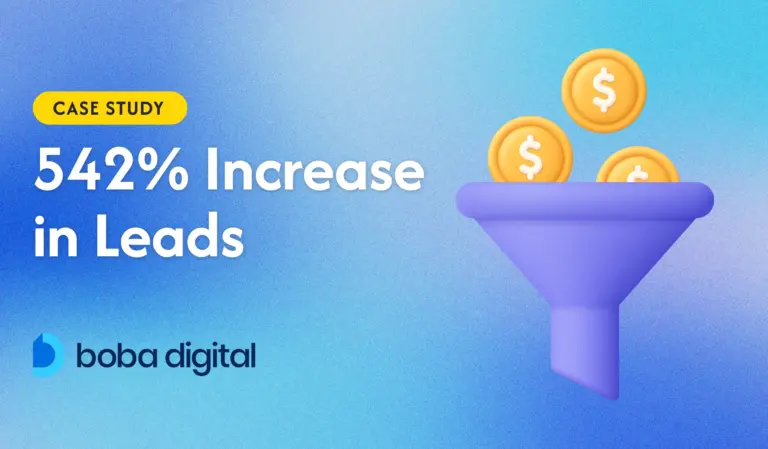What is Event Count in Google Analytics: A Simple Guide
User interactions in Google Analytics measure how frequently users perform specific actions on your website or app, such as clicks and form submissions. Knowing what is event count in Google Analytics helps you understand user behavior, improve engagement, and make data-driven decisions. In this article, we’ll explore what an event count is, why it matters, and how to set it up.
Key Takeaways
- Event count in Google Analytics tracks user actions like clicks and page views, helping you understand user engagement.
- Using event count data lets you optimize user interactions and improve conversion rates by tailoring strategies based on insights.
- There are two main types of events: automatically collected (like page views) and custom events (specific to your business), both crucial for effective tracking.
- Implementing the event tracking code is essential for accurate data collection and ensures that all user interactions are properly recorded.
What Is Event Count in Google Analytics?
Event count in Google Analytics refers to the frequency of specific user actions tracked on your website or app. These actions can range from simple clicks and form submissions to video plays and page views. Defining and implementing event tracking allows you to monitor these interactions and gather valuable insights into how users engage with your digital properties.
Event data is collected using an event tracking code implemented on the website or app.
The Events report in Google Analytics 4 (GA4) is a powerful tool that provides detailed information on event counts. This report helps in understanding user interactions better and making data-driven decisions to improve user experience and achieve business goals. The first step towards harnessing this powerful feature is implementing event tracking, which can be analyzed through google analytics reports.
Understanding Event Data
Event data is a crucial component of Google Analytics, providing valuable insights into user interactions on a website or app. It measures the number of times a specific event occurs, such as button clicks, video plays, or form submissions. By analyzing event data, businesses can understand how users engage with their website, identify areas for improvement, and optimize their online presence.
Event data is collected through event tracking, which involves adding code to specific elements on a website or app. This code sends data to Google Analytics, allowing businesses to track and analyze user behavior. For instance, if you want to track how often users submit a contact form, you would implement event tracking on the form submission button. This data is then sent to Google Analytics, where it can be analyzed to gain insights into user interactions.
Event data can be categorized into different types, including user interaction events, social interaction events, and custom events. User interaction events might include actions like clicks and scrolls, while social interaction events could track shares and likes. Custom events are tailored to specific business goals, providing deeper insights into unique user behaviors. By leveraging these different types of event data, businesses can gain a comprehensive understanding of how users interact with their digital properties.
The Importance of Event Count Data
Event count data provides insights into user interactions and assesses the effectiveness of specific actions on your website or app. Analyzing this data helps identify which elements engage users and which ones cause drop-offs. This understanding can help optimize the user journey, leading to higher engagement and conversion rates.
High event counts are indicative of more engaged users, signaling that your content or features are resonating well with your audience. Defining event count data also informs product development, service offerings, and marketing strategies, making it a crucial metric to track event count for business growth. Tailoring strategies based on this data allows for a more personalized and effective approach to meeting client goals.
Moreover, segmenting audiences using event count data helps in crafting personalized marketing strategies that can significantly boost conversion rates and overall performance. Understanding event count data is not just about tracking numbers; it’s about making informed decisions that drive business success.
If you want to better estimate the value of these decisions, check out our SEO ROI calculator to help you quantify the return on your organic marketing efforts.
Types of Events in Google Analytics
Google Analytics categorizes events into two main types: automatically collected events and custom events. Automatically collected events are those that Google Analytics tracks by default, such as page views and scrolls, without the need for additional setup. Custom events, on the other hand, are user-defined and tailored to track specific actions that are unique to your business goals. Custom events require the implementation of an event tracking code.
Effective event tracking requires understanding these types of events and how they work. Automatically collected events provide a baseline of user engagement, while custom events offer deeper insights into user interactions with specific elements on your site.
Automatically Collected Events
Automatically collected events are a boon for marketers because they eliminate the need for manual setup, making data collection more straightforward. Examples of such events include page views and scroll depth, which are crucial for understanding user engagement with your content. Leveraging these automatically tracked events provides insights into how users navigate through your site and interact with different elements.
Automatically collected events capture essential user interactions efficiently, contributing to improved analytics and better decision-making. This foundational data allows you to focus on more complex custom events that require specific tracking parameters.
Custom Events
Custom events are designed to track specific actions that are unique to your business objectives, such as form submissions, video plays, or button clicks. Custom events require the implementation of an event tracking code. These events provide richer data, enabling more detailed analysis of user interactions. To create custom events, you need to define an event name and associated event parameters, ensuring that these metrics align with your business goals.
While custom events offer more granular insights, it’s essential to be mindful of system limits and potential data sampling. Proper implementation and monitoring of custom events can significantly enhance your understanding of user behavior and help in making informed decisions that drive business growth.
Setting Up Event Tracking in Google Analytics
Setting up event tracking in Google Analytics is a critical step in capturing valuable insights about user interactions. By integrating event tracking, you can go beyond basic metrics and gain a deeper understanding of how users interact with your website or app. This involves using the Google tag (gtag.js) and the event tracking code to send event data to Google Analytics.
The process involves defining the events you want to track, implementing the tracking code on your site, and configuring your Google Analytics account to record these events. Proper setup ensures that you capture all relevant user interactions, enabling comprehensive analysis and better decision-making.
Avoiding Common Mistakes
Common pitfalls in event tracking can lead to inaccurate data collection, which can skew your analysis and decision-making. One major mistake is placing event tracking code above the Google tag snippet, which prevents data processing for those events. To avoid such errors, it’s crucial to verify event implementations through the Realtime and DebugView reports.
Optimizing event triggers involves aligning them with user behavior and refining the conditions for triggering. By fine-tuning these triggers, you ensure that your data accurately reflects user interactions, leading to more reliable insights and better-informed decisions.
Interpreting Event Count Data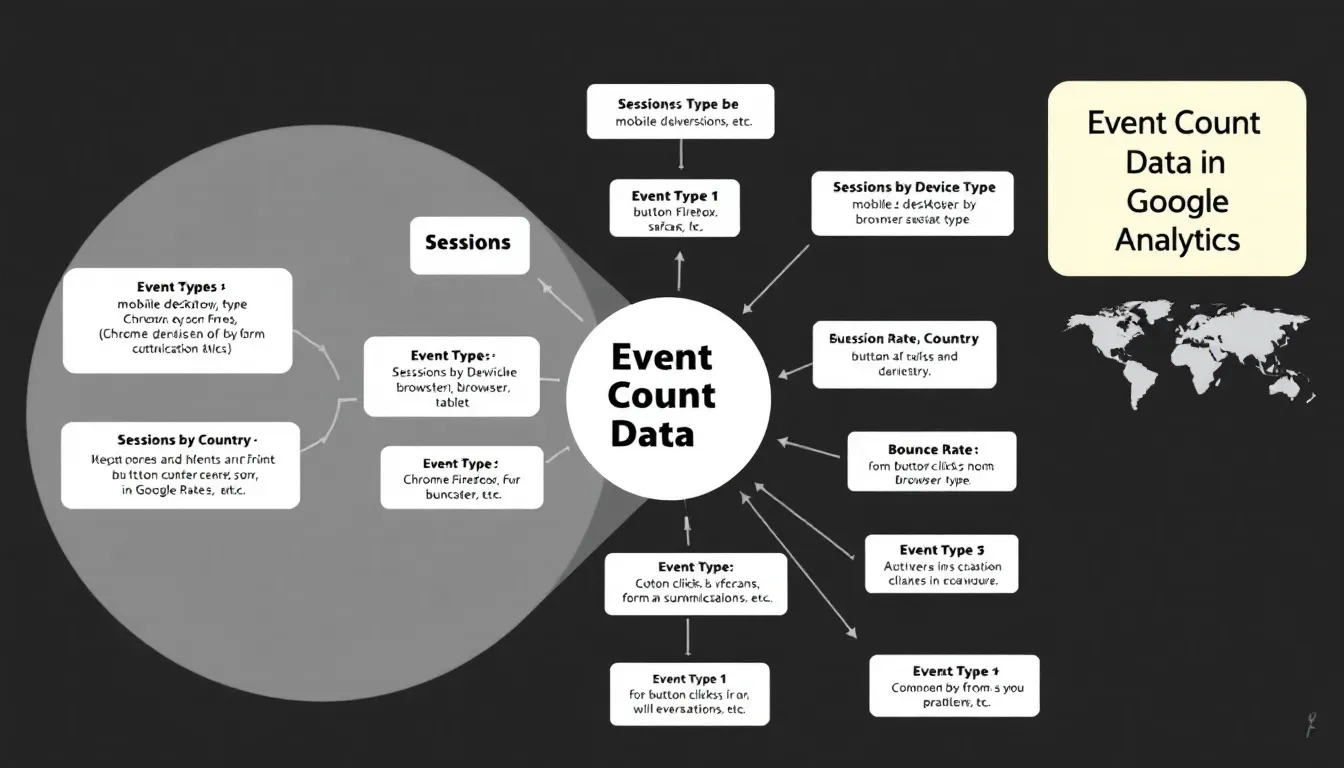
Interpreting event count data is crucial. It helps in obtaining strategic business intelligence. By analyzing how often specific events occur, you can gain insights into user engagement and behaviors on your website or app. The Events report in Google Analytics 4 provides a comprehensive overview of the quantity and frequency of user interactions, helping businesses identify effective website elements that drive engagement.
Event count metrics are invaluable for understanding user preferences and making data-driven decisions that enhance user experience and drive business growth. By interpreting this data correctly, you can optimize your website to better meet user needs and achieve your business objectives.
Analyzing Event Reports
Event reports can be analyzing event data to identify patterns and trends. This process also highlights areas that may require improvement. By studying these reports, you can gain valuable insights into user behavior, preferences, and areas that need enhancement. Sudden changes in event count should trigger immediate diagnostics to understand the underlying causes and address any issues promptly.
A/B testing different website variations can also help optimize event tracking effectiveness, ensuring that you capture accurate data that reflects true user interactions. This iterative process leads to continuous improvement and better user experience.
Using Data to Enhance User Experience
Using event count data to enhance user experience involves analyzing user interactions with your website or app and identifying areas for improvement. A low event count for a feature indicates that users are not engaging with it, prompting a review and possible redesign of that feature. Addressing these issues increases engagement, conversion rates, and business growth.
Descriptive event labels enhance the clarity and usability of event data, making it easier to analyze and use for targeted improvements. This approach ensures that your website or app continually evolves to meet user needs and preferences.
Event Data and User Engagement
Event data is closely tied to user engagement, as it measures the interactions users have with specific elements on a website or app. By analyzing event data, businesses can gain insights into user behavior, preferences, and engagement levels. This information can be used to optimize the user experience, improve conversion rates, and drive business growth.
For example, if event data shows that a significant number of users are clicking on a particular button but not completing the desired action, it may indicate a usability issue that needs to be addressed. By identifying and resolving such issues, businesses can enhance user engagement and increase conversions.
Event data can also be used to identify areas where users may encounter difficulties or drop-off points in their journey. For instance, if a high drop-off rate is observed at a specific step in a form submission process, it may suggest that the form is too complex or confusing. By simplifying the form or providing clearer instructions, businesses can improve user engagement and reduce drop-offs.
Additionally, event data can be used to create custom audiences and conversion events, allowing businesses to target specific user groups and measure the effectiveness of their marketing efforts. In Google Analytics 4, event data is a fundamental metric for quantifying user interactions and engagement with a website. It informs resource allocation and campaign strategy, making it an essential KPI for effective digital marketing.
By tracking and analyzing event data, businesses can uncover valuable insights into user behavior, preferences, and engagement levels. This information can be used to drive business growth, improve the user experience, and achieve business objectives.
Event Count and SEO
Higher event counts can positively influence search engine rankings by reflecting user engagement. Search engines may use event counts as an indicator of a website’s relevance and popularity, potentially influencing rankings. Frequent user interactions, represented by higher event counts, can signal to search engines that a site offers valuable content.
Improved event counts signal user satisfaction, enhancing a site’s credibility and authority in the eyes of search engines. Focusing on increasing event counts through better user engagement helps improve SEO and attract more organic traffic.
Event Count Best Practices
Event count analysis can reveal which elements on a website are most effective in driving user interactions. Leveraging these insights can inform feature enhancements and overall website design, ensuring that your site meets user needs and preferences. To enhance the number of tracked events, identify key events such as button clicks and form submissions. Correctly implementing the event tracking code is crucial to ensure accurate data collection and analysis.
Descriptive event categories and labels aid in accurate future data analysis, making it easier to interpret and utilize insights from event count data.
Optimizing Event Triggers
Refining event triggers ensures they align accurately with specific user actions. Testing and adjusting triggers ensures they reflect user actions accurately, leading to more reliable data collection and analysis.
This process helps in capturing the most relevant user interactions and gaining deeper insights into user behavior. Correctly implementing the event tracking code is crucial for ensuring that all user actions are accurately recorded and analyzed.
Clear Event Labels
Clear event labels are essential in Google Analytics for enhancing data categorization and analysis. Clear labels allow for better data organization, making it easier to interpret and utilize insights from event count data. Clear event names and relevant parameters maximize the effectiveness of custom events.
Clear event labels improve analysis capabilities and informed decision-making based on accurate data. This approach ensures that your event tracking efforts yield meaningful insights that drive business success. Correctly implementing the event tracking code is crucial to ensure that all events are accurately recorded and analyzed.
Creating Custom Reports
Creating custom reports in Google Analytics 4 involves analyzing user interactions using the Explorations feature, which includes various types like Free Form, Funnel, and Path explorations. The Variables section in the Explorations interface allows you to select the segments, dimensions, and metrics utilized in your custom report. Applying filters in custom reports helps narrow down data, focusing on specific user segments or excluding particular events.
The Tab Settings column allows users to configure the appearance and type of the report, including visualization options like tables and charts. Reports generated through Explorations can be saved, shared, and duplicated, making it easier to collaborate and refine your analysis.
Using Event Count Data for Business Growth
Effectively using event count data and analyzing user interactions can significantly enhance business growth by focusing on tracking events that have a direct impact on business goals. For example, tracking contact form submissions on an eCommerce website provides valuable insights into user engagement and areas for improvement. Understanding user engagement through event count data can optimize user experience, improve conversion rates, and identify areas for enhancement.
Combining precise tracking with persuasive analysis enables businesses to leverage event count data to achieve their objectives and drive growth. Every interaction is measured and analyzed to inform strategic decisions with this approach.
Summary
Understanding event counts in Google Analytics is a powerful tool for gaining insights into user interactions and optimizing your digital strategy. By tracking and analyzing event counts, you can identify areas for improvement, enhance user experience, and drive business growth. Implementing best practices in event tracking and interpretation ensures that you capture accurate and meaningful data.
As you apply these insights, remember that continuous monitoring and refinement are key to success. By staying proactive and data-driven, you can achieve your business goals and create a more engaging and effective online presence.
Frequently Asked Questions
What is an event count in Google Analytics?
An event count in Google Analytics shows how often specific actions are taken by users on your site or app, giving you insight into user interactions. It’s a handy way to understand what’s happening on your platform!
Why is event count data important?
Event count data is super important because it helps you understand user behavior and make smarter business decisions. By analyzing this data, you can enhance user experience and drive better outcomes.
What are automatically collected events in Google Analytics?
Automatically collected events in Google Analytics are the default actions it tracks for you, like page views and scrolls, so you don’t have to set anything up. It’s a hassle-free way to monitor user engagement right out of the box!
How do custom events differ from automatically collected events?
Custom events are all about tracking specific actions that matter to your business, while automatically collected events are standard actions logged without extra effort. Essentially, if you want deeper insights into unique user behavior, go custom!
How can event count data be used to improve SEO?
Using event count data can boost your SEO since higher engagement shows search engines that your content is valuable, leading to better rankings. So, keep an eye on those stats!

